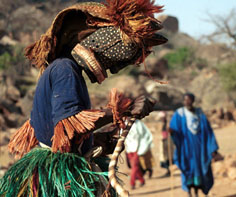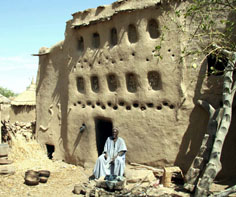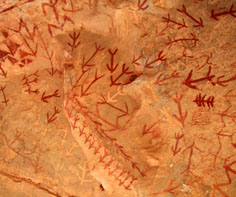|
 |
Seasonal &
funerary rituals : masked dance performances are held on the
occasion
of funerary rites
and are governed by the « Society of the Masks ». It gathers all
circumcised men, young and old. It has no architectural edifice where
to practise its cult. Masks are « things » from the bush. Rites and
sacrifices are performed in a cave outside the village.
In mythical times, death did not exist. Men metamorphosed into
serpents. Yet, after the breaking of a taboo, the Dogon were exposed to
death. The Society of the Masks celebrates the cult of Dyongou Serou,
the first ancestor who died in the form of a serpent. Death has ever
since been transmitted to men through contagion.
On the occasion of a funeral for a man, the masks leave their rock
shelter and enter the village. They attract the deceased out of his
house and towards sunset they return to the bush followed by his soul.
Many visitors come and offer condolences to the family of the departed.
Mock battles and dances are held around the clock. Songs retrace the
deceased’s life story and exploits. Other songs refer to aspects of the
local history of the village. Close relatives and visitors mime battle
scenes in the village centre and on the roof terrace of the deceased.
These battles are directed against the old Fulani enemy. They fire
blank shots with locally made flint rifles and fight with spears,
shields and lit torches. The echo of the cliff reflects back the gun
detonations. The noise is ear-splitting and participants are shrouded
in a cloud of gunpowder. Some of the personal belongings of the
deceased are deposited on the roof terrace of his house. If he was an
old war veteran, a life-size dummy dressed in military garb will be
clearly visible from all around. His widows dance in front of the house
entrance with broken gourds held up high above their heads. They will
no longer be used for their husband’s meals. Some dignitaries and close
parents climb on the roof and sacrifice a goat. In Koundou, a man
castrates the goat, slits its throat and throws the corpse from the
roof onto the ground. The purpose of the sacrifice is to help the
deceased on his way to the hereafter. It is now the masked dancers'
turn to climb onto the roof terrace and dance. They pay a last homage
to the dead man and climb down. A close parent remains alone on the
roof, kneels down, scratches the ground with his hands and throws earth
over his shoulders. By doing so he is looking for the soul of the
deceased that is to return in a baby still to be born. The transmission
of the dead man's soul to a descendent, is a form of reincarnation.
When grown up, the latter will make regular offerings to his dead
parent on the ancestor altar. The world of the living is a dangerous
and uncertain place. By taking care of his dead parent, the respondent
will benefit from his support.
|
|
 |
Dogon
architecture - the ginna : The social structure of Dogon
villages is
based on descent groups. Patrilineal families are each headed by a
patriarch whose authority extends over all family members. They live in
compounds neighbouring the Ginna, the residence of the patriarch (Ginna
Banga). It is the village founder’s house and the most senior member
among his successors lives there. Large villages are divided into
districts and each has its own Ginna, a two storied building with a
façade showing rows of superimposed niches. The ancestor altar (Wagem)
is located in a covered structure that gives onto the roof terrace: a
set of bowls that serve as receptacles for the dead who come and drink
there. It is a place where Ginna members commemorate the recently dead
and distant ancestors who are long forgotten.
|
|
 |
Rock art in Dogon country : The
Sahara abounds with Neolithic
rock engravings that display the fauna and the human activities of
times past: wild animals, game hunting, pastoral sceneries, etc. Many
books are dedicated to the subject. What is not so well documented,
however, is rock art in Dogon country: the presence there of engravings
and paintings from the Neolithic period has not been proved so far.
They seem to belong to a much later phase. Figurative representations
are hard to find. Most rock sites show geometric compositions and
sometimes one can make out stylized human figures. But in absence of
archaeological data for age determination, it is difficult to
differentiate pre-dogon rock art from engravings and paintings that
date from later times when invaders and indigenous populations were
sharing a common territory. And what to say about their makers and
about their ethnic affiliation? Also, the meaning and ritual use of
these ancient rock sites has long been forgotten. Today, traditional
rock painting is still alive: circumcision rites and mask rituals
hidden from public view. This way we can make ourselves an idea in what
context this art form is used. It now remains to be seen whether a
discipline such as ethnoarchaeology would still be able to decipher the
meaning of ancient rock art.
|